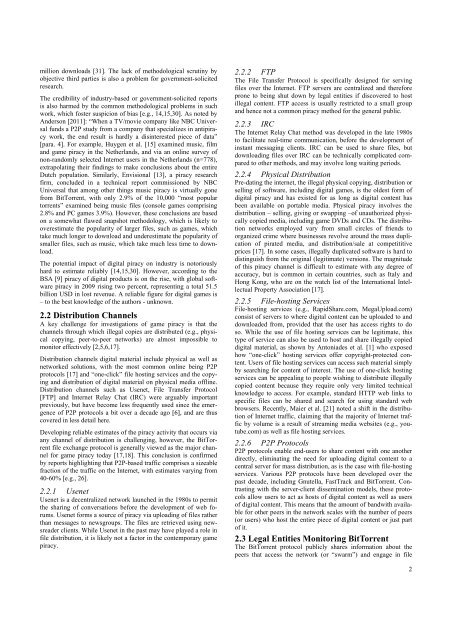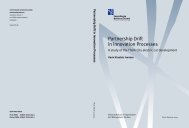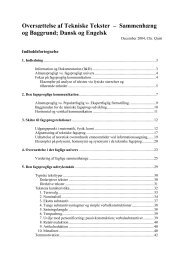Piracy Activity vs. Product Features in Digital Games - OpenArchive ...
Piracy Activity vs. Product Features in Digital Games - OpenArchive ...
Piracy Activity vs. Product Features in Digital Games - OpenArchive ...
Create successful ePaper yourself
Turn your PDF publications into a flip-book with our unique Google optimized e-Paper software.
million downloads [31]. The lack of methodological scrut<strong>in</strong>y by<br />
objective third parties is also a problem for government-solicited<br />
research.<br />
The credibility of <strong>in</strong>dustry-based or government-solicited reports<br />
is also harmed by the common methodological problems <strong>in</strong> such<br />
work, which foster suspicion of bias [e.g., 14,15,30]. As noted by<br />
Anderson [2011]: “When a TV/movie company like NBC Universal<br />
funds a P2P study from a company that specializes <strong>in</strong> antipiracy<br />
work, the end result is hardly a dis<strong>in</strong>terested piece of data”<br />
[para. 4]. For example, Huygen et al. [15] exam<strong>in</strong>ed music, film<br />
and game piracy <strong>in</strong> the Netherlands, and via an onl<strong>in</strong>e survey of<br />
non-randomly selected Internet users <strong>in</strong> the Netherlands (n=778),<br />
extrapolat<strong>in</strong>g their f<strong>in</strong>d<strong>in</strong>gs to make conclusions about the entire<br />
Dutch population. Similarly, Envisional [13], a piracy research<br />
firm, concluded <strong>in</strong> a technical report commissioned by NBC<br />
Universal that among other th<strong>in</strong>gs music piracy is virtually gone<br />
from BitTorrent, with only 2.9% of the 10,000 “most popular<br />
torrents” exam<strong>in</strong>ed be<strong>in</strong>g music files (console games compris<strong>in</strong>g<br />
2.8% and PC games 3.9%). However, these conclusions are based<br />
on a somewhat flawed snapshot methodology, which is likely to<br />
overestimate the popularity of larger files, such as games, which<br />
take much longer to download and underestimate the popularity of<br />
smaller files, such as music, which take much less time to download.<br />
The potential impact of digital piracy on <strong>in</strong>dustry is notoriously<br />
hard to estimate reliably [14,15,30]. However, accord<strong>in</strong>g to the<br />
BSA [9] piracy of digital products is on the rise, with global software<br />
piracy <strong>in</strong> 2009 ris<strong>in</strong>g two percent, represent<strong>in</strong>g a total 51.5<br />
billion USD <strong>in</strong> lost revenue. A reliable figure for digital games is<br />
– to the best knowledge of the authors - unknown.<br />
2.2 Distribution Channels<br />
A key challenge for <strong>in</strong>vestigations of game piracy is that the<br />
channels through which illegal copies are distributed (e.g., physical<br />
copy<strong>in</strong>g, peer-to-peer networks) are almost impossible to<br />
monitor effectively [2,5,6,17].<br />
Distribution channels digital material <strong>in</strong>clude physical as well as<br />
networked solutions, with the most common onl<strong>in</strong>e be<strong>in</strong>g P2P<br />
protocols [17] and “one-click” file host<strong>in</strong>g services and the copy<strong>in</strong>g<br />
and distribution of digital material on physical media offl<strong>in</strong>e.<br />
Distribution channels such as Usenet, File Transfer Protocol<br />
[FTP] and Internet Relay Chat (IRC) were arguably important<br />
previously, but have become less frequently used s<strong>in</strong>ce the emergence<br />
of P2P protocols a bit over a decade ago [6], and are thus<br />
covered <strong>in</strong> less detail here.<br />
Develop<strong>in</strong>g reliable estimates of the piracy activity that occurs via<br />
any channel of distribution is challeng<strong>in</strong>g, however, the BitTorrent<br />
file exchange protocol is generally viewed as the major channel<br />
for game piracy today [17,18]. This conclusion is confirmed<br />
by reports highlight<strong>in</strong>g that P2P-based traffic comprises a sizeable<br />
fraction of the traffic on the Internet, with estimates vary<strong>in</strong>g from<br />
40-60% [e.g., 26].<br />
2.2.1 Usenet<br />
Usenet is a decentralized network launched <strong>in</strong> the 1980s to permit<br />
the shar<strong>in</strong>g of conversations before the development of web forums.<br />
Usenet forms a source of piracy via upload<strong>in</strong>g of files rather<br />
than messages to newsgroups. The files are retrieved us<strong>in</strong>g newsreader<br />
clients. While Usenet <strong>in</strong> the past may have played a role <strong>in</strong><br />
file distribution, it is likely not a factor <strong>in</strong> the contemporary game<br />
piracy.<br />
2.2.2 FTP<br />
The File Transfer Protocol is specifically designed for serv<strong>in</strong>g<br />
files over the Internet. FTP servers are centralized and therefore<br />
prone to be<strong>in</strong>g shut down by legal entities if discovered to host<br />
illegal content. FTP access is usually restricted to a small group<br />
and hence not a common piracy method for the general public.<br />
2.2.3 IRC<br />
The Internet Relay Chat method was developed <strong>in</strong> the late 1980s<br />
to facilitate real-time communication, before the development of<br />
<strong>in</strong>stant messag<strong>in</strong>g clients. IRC can be used to share files, but<br />
download<strong>in</strong>g files over IRC can be technically complicated compared<br />
to other methods, and may <strong>in</strong>volve long wait<strong>in</strong>g periods.<br />
2.2.4 Physical Distribution<br />
Pre-dat<strong>in</strong>g the <strong>in</strong>ternet, the illegal physical copy<strong>in</strong>g, distribution or<br />
sell<strong>in</strong>g of software, <strong>in</strong>clud<strong>in</strong>g digital games, is the oldest form of<br />
digital piracy and has existed for as long as digital content has<br />
been available on portable media. Physical piracy <strong>in</strong>volves the<br />
distribution – sell<strong>in</strong>g, giv<strong>in</strong>g or swapp<strong>in</strong>g –of unauthorized physically<br />
copied media, <strong>in</strong>clud<strong>in</strong>g game DVDs and CDs. The distribution<br />
networks employed vary from small circles of friends to<br />
organized crime where bus<strong>in</strong>esses revolve around the mass duplication<br />
of pirated media, and distribution/sale at competititive<br />
prices [17]. In some cases, illegally duplicated software is hard to<br />
dist<strong>in</strong>guish from the orig<strong>in</strong>al (legitimate) versions. The magnitude<br />
of this piracy channel is difficult to estimate with any degree of<br />
accuracy, but is common <strong>in</strong> certa<strong>in</strong> countries, such as Italy and<br />
Hong Kong, who are on the watch list of the International Intellectual<br />
Property Association [17].<br />
2.2.5 File-host<strong>in</strong>g Services<br />
File-host<strong>in</strong>g services (e.g., RapidShare.com, MegaUpload.com)<br />
consist of servers to where digital content can be uploaded to and<br />
downloaded from, provided that the user has access rights to do<br />
so. While the use of file host<strong>in</strong>g services can be legitimate, this<br />
type of service can also be used to host and share illegally copied<br />
digital material, as shown by Antoniades et al. [1] who exposed<br />
how “one-click” host<strong>in</strong>g services offer copyright-protected content.<br />
Users of file host<strong>in</strong>g services can access such material simply<br />
by search<strong>in</strong>g for content of <strong>in</strong>terest. The use of one-click host<strong>in</strong>g<br />
services can be appeal<strong>in</strong>g to people wish<strong>in</strong>g to distribute illegally<br />
copied content because they require only very limited technical<br />
knowledge to access. For example, standard HTTP web l<strong>in</strong>ks to<br />
specific files can be shared and search for us<strong>in</strong>g standard web<br />
browsers. Recently, Maier et al. [21] noted a shift <strong>in</strong> the distribution<br />
of Internet traffic, claim<strong>in</strong>g that the majority of Internet traffic<br />
by volume is a result of stream<strong>in</strong>g media websites (e.g., youtube.com)<br />
as well as file host<strong>in</strong>g services.<br />
2.2.6 P2P Protocols<br />
P2P protocols enable end-users to share content with one another<br />
directly, elim<strong>in</strong>at<strong>in</strong>g the need for upload<strong>in</strong>g digital content to a<br />
central server for mass distribution, as is the case with file-host<strong>in</strong>g<br />
services. Various P2P protocols have been developed over the<br />
past decade, <strong>in</strong>clud<strong>in</strong>g Gnutella, FastTrack and BitTorrent. Contrast<strong>in</strong>g<br />
with the server-client dissem<strong>in</strong>ation models, these protocols<br />
allow users to act as hosts of digital content as well as users<br />
of digital content. This means that the amount of bandwith available<br />
for other peers <strong>in</strong> the network scales with the number of peers<br />
(or users) who host the entire piece of digital content or just part<br />
of it.<br />
2.3 Legal Entities Monitor<strong>in</strong>g BitTorrent<br />
The BitTorrent protocol publicly shares <strong>in</strong>formation about the<br />
peers that access the network (or “swarm”) and engage <strong>in</strong> file<br />
2
















